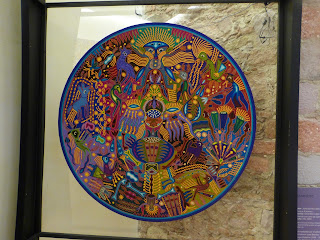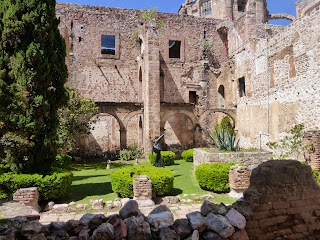And so we continue our circular two-week road trip around central Mexico: Durango - Zacatecas - Aguascalientes - Tlaquepaque/Tonala - Tequila - Tepic - Mazatlan:
Zacatecas
This UNESCO World Heritage Site city, the capital of the state of Zacatecas, would be a great tourist stop any time of the year, in large part due to its well-preserved colonial and post-independence architecture, plazas and charming, twisting streets:
Well, it was mostly lucky that our stay coincided with the festival . . .
 |
| Doors to Templo de Santo Domingo |
 |
| Avenida Hidalgo - Lined With Purveyors of Sweets! |
Cultural Festival
But we lucked out by (without intention) arriving during the city's 29th Cultural Festival. The city hosted music every night during our stay in several venues - for 30 pesos ($2 US) a ticket! And there were several festival-specific art installations. |
| Sculptures of the Mexican Artist, Sebastian, in the Ex-Templo de San Agustin |
 |
| A Street-Side Furniture Making/Painting Event |
Well, it was mostly lucky that our stay coincided with the festival . . .
The Quinta Real Zacatecas is one of Mexico's most interesting luxury hotels - it is built into the city's old bull ring. And after a few days of living "basic" in Sombrerete we were ready for some luxury. This hotel did not disappoint - a beautiful room, great views from the good restaurant (down into the bull ring), attentive service . . . even monogrammed slippers and bathrobes!
Sadly, this lovely hotel was only a block away from the heavy metal / hard rock venue for the cultural festival and the bull-ring design acted to amplify the offerings of heavy metal/hard rock groups such as "Steel Bikers" and the "metal core rock" group "Four Again". We did luck out one day -- even though we got soaked walking back to the hotel -- "Ixion" and "Memorias de Ceniza" were rained out.
 |
| Former Bull Ring - Now A Luxury Hotel |
Sadly, this lovely hotel was only a block away from the heavy metal / hard rock venue for the cultural festival and the bull-ring design acted to amplify the offerings of heavy metal/hard rock groups such as "Steel Bikers" and the "metal core rock" group "Four Again". We did luck out one day -- even though we got soaked walking back to the hotel -- "Ixion" and "Memorias de Ceniza" were rained out.
We didn't suffer a great deal, though - we left the heavy metalists to themselves and attended music-related events more to our liking. One was a performance art piece that combined story telling and a flute and piano duo interpreting Mouquet's La Flute de Pan and Reinecke's Sonata Undine. We enjoyed the evening even though Molly's Spanish was not up to following the story closely . . .
Our second musical outing was to "Flamenco Fusion" by the Mexico City group Elohim y Tarantos. No translation was needed to enjoy their energetic rock-flamenco music and flamenco dancing. If you happen upon this group, or their flamenco dancer Marcela Morin - we encourage you to go!!!
 |
| It's Hard To Capture That Much Movement! |
Museums
But as we said earlier - Zacatecas would be a great tourist stop during any time of the year. We pulled ourselves away from our luxurious hotel room to check off most of the "must do" sites:
Museo Zacatecano: This museum is located in a beautiful 19th Century building which once housed one of the early Mexican national mints. The museum has an unfocused collection of zacatecano historic stuff and art that wasn't very exciting. But we persevered, following the somewhat confusing arrows from room to room, and came upon the Salon Casa de Monedaas (Room of the Mint) where there are cool old machines that were used to make coins through much of early Mexican history, and the coins themselves which provided an interesting look into the financial chaos that reined during the early years of the Mexican Republic.
The real exhibit worth visiting is the Sala Art y Cultura de Huichol - the rooms displaying the art of the Huichol indigenous group. This group lives in Jalisco, Nayarit, Durango, and Zacatecas states, and is known for peyote religious rituals and bead-work art. But as this exhibit shows, they are also spectacular weavers and yarn artists:
Museo Zacatecano: This museum is located in a beautiful 19th Century building which once housed one of the early Mexican national mints. The museum has an unfocused collection of zacatecano historic stuff and art that wasn't very exciting. But we persevered, following the somewhat confusing arrows from room to room, and came upon the Salon Casa de Monedaas (Room of the Mint) where there are cool old machines that were used to make coins through much of early Mexican history, and the coins themselves which provided an interesting look into the financial chaos that reined during the early years of the Mexican Republic.
The real exhibit worth visiting is the Sala Art y Cultura de Huichol - the rooms displaying the art of the Huichol indigenous group. This group lives in Jalisco, Nayarit, Durango, and Zacatecas states, and is known for peyote religious rituals and bead-work art. But as this exhibit shows, they are also spectacular weavers and yarn artists:
 |
| Huichol Weaving - Bandera (Mexican Flag) Colors |
 |
| Intricate Yarn Art |
This exhibit also includes a photographic study of a pilgrimage taken by a group of Huichol to gather peyote and visit important ritual sites. This pilgrimage is undertaken by many different groups of Huichols each year. The peyote is used by community members to communicate with ancestors.
Museo Rafael Coronel: This museum is housed in the ruins of a 16th Century convent (Ex-Convento de San Francisco) and is a destination museum for anyone interested in Mexican folk art masks.
 |
| Ex-Convento de San Francisco |
The museum houses the mask collection of Zacatecan artist Rafael Coronel who is famous for, among other things, being the son-in-law of Diego Rivera. This collection is vast - over 3,000 masks are on display - and can be enjoyed as a collection of art works. However, if you have an interest in them as anthropology you may want to try to arrange for a guided tour.
The masks are hung in groups, primarily in relation to the dances in which they were used. But the museum doesn't provide a lot of context about those dances. For example, it was clear even to us that these masks had something to do with devil cows, but we weren't able to follow why devil cows might be important:
 |
| Devil Cows |
Many of the masks were used in dances about evil Spaniards (red skinned, blue eyed and white haired).
 |
| Devil Spaniard (We Think) |
And some of the masks were of regular scary devilish devils.
 |
| Pretty Sure We Get This One |
 |
| Devils and Women (Mujeres) - A Common Theme Everywhere |
There are walls upon walls of similar-looking masks used in ritual dances . . .
about which we know nothing, but which are cool to look at nonetheless.
 |
| Masks |
In general we wanted more anthropological context which isn't really what this museum is all about. So if you go, try to leave your anthropology questions behind and focus on the artistry of the masks and you'll enjoy your visit more.
The other display that particularly captured Molly's attention was one about the Rosete Aranda Gran Compania de Titeres, a marionette troupe that performed in Mexico from 1835 - 1958. The intricacy of the puppetry is amazing:
 |
| The Mexican Army |
 |
| The Circus |
 |
| A Bullfight |
We were just sorry we couldn't see them in motion!
Teleferico and Museo de la Toma de Zacatecas: At some point during the last half of the 20th Century each of the central-Mexico state capitals installed a teleferico (gondola ride) to the city's highest viewing point. There are telefericos in Durango, Zacatecas, Aguascaliente and Guanajuato . . . We can only suspect that some salesman for some Swiss cable car company made millions.
 |
| The Teleferico |
In most cities it's all about the view - regardless of whether it's a spectacular view (see our post about Durango's teleferico). In Zacatecas it's about the battle fought on the side of the hill in 1914 known as the "Taking (Toma) of Zacatecas". The battle was a decisive one during the long-drawn-out Mexican Revolution (1910-1917).
 |
| The Museum About The Battle - Heavy on Pancho Villa's Participation |
 |
| A Memorial to the Fallen |
 |
| And Because It's Mexico - The Memorial Is Also a Climbing Gym for Kids |
So that's our take on Zacatecas - a city well worth a visit even if you don't stay in the fancy hotel in the bull ring.
On to Aguascaliente - which, frankly, we didn't expect much of . . .
I love reading about your travels in Mexico! You find such fascinating places, and your stories always bring back wonderful memories of my time in Mexico. Those Huichol weavings look incredible. I have three yarn paintings that I bought many years ago. The Plaza de Toros turned into a luxury hotel is brilliant! Have fun!
ReplyDelete